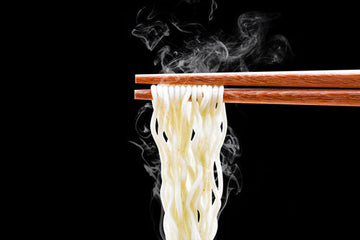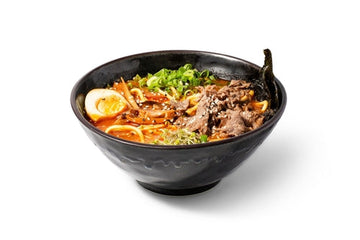Ramen noodles have gone from humble origins to becoming a global culinary phenomenon. For college students, busy professionals, and late-night snackers alike, they offer a quick, comforting, and affordable meal.
But amid their popularity, questions continue to arise: Are ramen noodles bad for you? To answer that, we need to look beyond the bowl and examine what’s really inside.
A Global Staple: Understanding Instant Ramen's Appeal
Instant ramen’s appeal lies in its convenience, long shelf-life, and crave-worthy flavors. Originally developed in Japan in the 1950s, ramen has since exploded in popularity worldwide. In fact, over 100 billion servings are consumed annually. Its low cost and accessibility make it a go-to for many—but affordability often comes with trade-offs.
Common Concerns and Criticisms Surrounding Ramen Noodles
Despite its convenience, instant ramen faces widespread criticism from health experts and nutritionists. Common concerns include high sodium levels, lack of essential nutrients, and the presence of artificial additives. But is it all bad news? Let’s break it down.
Deconstructing Instant Ramen: What's Really Inside?
The Noodles Themselves: Ingredients and Processing
Instant ramen noodles are usually made from refined wheat flour, salt, and palm oil, then deep-fried or air-dried to increase shelf stability. This processing strips away much of the fiber and nutrients, resulting in a starchy, calorie-dense food with minimal health benefits.
The Flavor Packet: Sodium, Additives, and Flavor Enhancers
The small silver flavor packet that packs a punch is often where most of the health concerns lie. These packets typically contain:
-
High sodium content (up to 1,800 mg or more—almost the entire daily recommended limit)
-
Monosodium glutamate (MSG)
-
Artificial colors and preservatives
While these ingredients enhance taste and shelf life, they also contribute to the food’s ultra-processed label.
Nutritional Profile: Calories, Macronutrients, and Micronutrients
A single serving of instant ramen provides around:
-
380–450 calories
-
14 grams of fat
-
50–60 grams of carbohydrates
-
8–10 grams of protein
However, ramen is notoriously lacking in fiber, vitamins, and minerals—essential components of a balanced meal.
Potential Health Concerns Associated with Instant Ramen
High Sodium Content and Its Impact on Health
Consistently consuming high-sodium foods can contribute to hypertension, heart disease, and stroke. Many instant ramen brands exceed the American Heart Association’s daily sodium recommendation in just one package.
Presence of MSG and Other Additives: Separating Fact from Fiction
MSG has been demonized in the past, but modern studies show it’s generally safe in moderate amounts. However, excessive intake of additives, preservatives, and flavor enhancers found in ramen may contribute to inflammation and other health issues over time.
The "Nutrient-Poor" Argument: Lack of Essential Vitamins and Minerals
Instant ramen offers little in terms of micronutrients. A diet heavy in such foods can lead to nutritional deficiencies, especially in populations relying on it as a staple.
Potential Link to Metabolic Syndrome
A 2014 study published in the Journal of Nutrition linked frequent instant noodle consumption to an increased risk of metabolic syndrome, especially in women. Symptoms include abdominal obesity, high blood pressure, and insulin resistance.
The Impact of Processing Methods
The deep-frying of noodles during production adds trans fats and decreases nutritional value. Even non-fried versions are highly refined and contribute to rapid blood sugar spikes.
Are All Ramen Noodles Created Equal? Exploring Variations
Instant Ramen vs. Fresh Ramen: A Nutritional Comparison
Fresh ramen, often served in restaurants, usually contains fresher ingredients, less sodium, and better quality proteins. It still isn't a health food, but it's typically far less processed than instant versions.
Restaurant-Style Ramen: Ingredients and Potential Benefits
Restaurants often use bone broth, fresh vegetables, and real meat or tofu, providing not only flavor but collagen, minerals, and protein. These bowls, though higher in calories, may offer better overall nutrition.
Gluten-Free Ramen Options: A Healthier Alternative?
For those with gluten sensitivity or celiac disease, gluten-free ramen made from rice, millet, or buckwheat offers a safer and sometimes more nutritious alternative. However, watch the sodium and flavor packets—those don’t always change with the noodle base.

Smart Ways to Enjoy Ramen Noodles (If You Choose To)
The "Hacks": Boosting Nutritional Value
Adding Protein (Eggs, Tofu, Chicken)
Including a source of lean protein helps balance the meal and increase satiety. A soft-boiled egg, grilled chicken, or tofu are great options.
Incorporating Vegetables (Spinach, Mushrooms, Carrots)
Toss in leafy greens, mushrooms, shredded carrots, or frozen peas to add fiber, vitamins, and antioxidants.
Choosing Lower-Sodium Flavoring Options
Opt for brands with reduced-sodium options or use homemade broth for flavor control.
Using Only Part of the Seasoning Packet
Sometimes, using just half (or less) of the seasoning can make a noticeable difference in sodium intake.
Moderation is Key: Making Ramen an Occasional Meal
Enjoy ramen occasionally rather than as a staple. It can fit into a balanced diet when paired with whole foods and consumed mindfully.
Healthier Alternatives to Instant Ramen
Exploring Other Quick and Easy Noodle Dishes
Try soba noodles with miso, zoodles with marinara, or whole-wheat pasta with veggies. These options offer better nutrient profiles without sacrificing convenience.
Focusing on Nutrient-Dense Meals
Build meals around whole grains, lean proteins, and fresh vegetables. Use spices, herbs, and natural broths to flavor your food without artificial additives.
Making Informed Choices About Ramen Noodles
Weighing the Pros and Cons
Instant ramen is cheap, tasty, and convenient—but it comes with trade-offs. High sodium, low nutrition, and ultra-processing make it less ideal as a frequent meal.
The Importance of a Balanced Diet
No single food will make or break your health. What matters is your overall dietary pattern. Including more whole foods and minimizing processed options is a step in the right direction.
Visit Yume FL
Ramen doesn’t have to be off the table entirely—but being mindful of how often and how it's prepared is key. Next time you crave a bowl, consider upgrading it with fresh add-ins or trying a healthier version.
Ready to try ramen the right way? Discover how Yume FL is redefining the noodle experience—one delicious, nourishing bowl at a time. Contact us!





